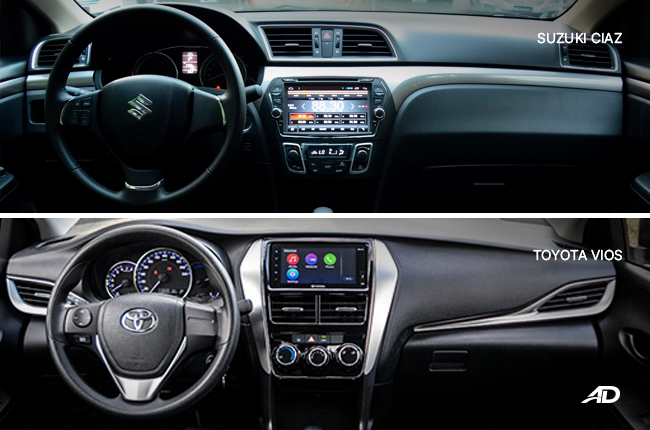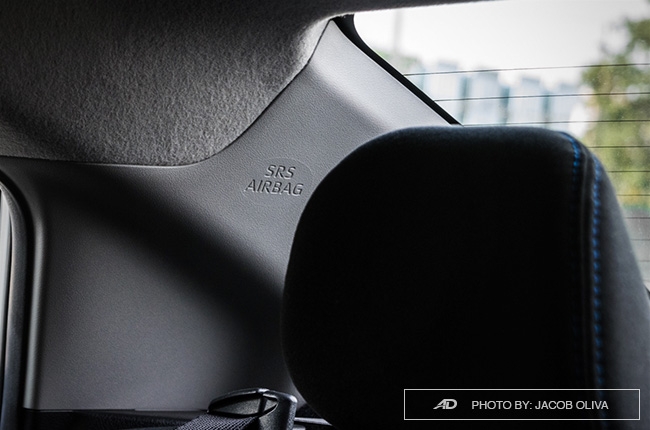
Subcompacts, love them or hate them, you cannot avoid them. They will always be a staple on Philippine roads no matter where you may be in the country. From taxis to TNVS, all the way to private owners and fleet cars, there is no denying that this car class is a mainstay for many motorists in the country.
Almost all manufacturers have at least one subcompact in their lineup. In this Head-to-Head portion, however, two Japanese brands are being featured. Here, we have an established nameplate and a model that is making a name for itself: The Toyota Vios and the Suzuki Ciaz.
Toyota is as strong as ever when it comes to its subcompact sedan offering, but the Ciaz emphasizes Suzuki’s specialty which is small cars that have good value for money.
Exterior

We know that style is subjective and beauty is in the eye of the beholder. We all know that everyone has their own tastes and preferences that go with choosing an automobile, but in this case, there are two camps.
While the Toyota Vios is a familiar sight on Philippine roads because there are so many of them, that doesn’t mean that this subcompact looks bad by any means. Some motorists will complain of the new model’s styling, while other drivers will love it. The looks are extended thanks to Toyota Motor Philippines’ (TMP) body enhancements in the Vios Prime variants. More demure variants are on offer from Toyota as well, but the option is there, as well as the aftermarket support for this nameplate.
The Suzuki Ciaz isn’t looking to stick out like a sore thumb. The styling is very conservative, and it doesn’t get all up in your grille as the Toyota Vios does with its massive faux air dam. The front has cuts and openings where it is needed, and it also features a good amount of chrome that enough to give it dimension, not necessarily style.
Then again, with the Toyota, you do get options when it comes to styling, so we’ll hand a slight edge to the Vios just because you can get it in a more aggressive-looking trim.
Interior

Hard plastics on both of them. While there are variants with synthetic leather seating, there is no denying the fact that this segment’s favorite material is hard plastic as seen in their dashboards, door cards, and center consoles.
The Toyota Vios is undoubtedly an avid fan of hard plastics, even incorporating a leather texture with faux stitching molded in. The theme runs throughout the dashboards and door cards, but even if it does seem solid, it’s a little hollow. The interior styling, however, is not as bad and is geared towards utility rather than all-out style.
The Suzuki Ciaz has a very straightforward interior and doesn’t look overdone in any way. The plastics that Suzuki uses are a much denser mold as compared to other manufacturers. The dashboard and door cards feel less hollow. The Ciaz will also have more space than the Vios because of its longer wheelbase. This means that the Suzuki has a borderline compact-sized wheelbase in a subcompact. This nets you a larger trunk capacity as well.

Even the headunits of both units were in a dead heat, offering similar functionality. Because of this, the Suzuki Ciaz edges out the Vios ever so slightly. Interior styling aside, quality of plastics and extra space are places where the Ciaz shines.
Driving
The Vios and Ciaz are both commuter cars. There is no way that these cars will light the world on fire with horsepower figures hovering around the 100-hp mark. In this case, performance should be judged by the feel of the car when it comes to driving and ownership.
Other than that, the engine is also strong enough even at 1.3L of displacement. It pulls when it needs to, but there is indeed merit when you opt for the 1.5L G variants. Instead of 98 hp with the 1.3L, you get 106 hp in the 1.5L. While it is not a lot, the smaller engine only produces 123 Nm of torque compared to the 140 Nm of the larger mill. The two engines are quite peppy and not lacking, but your mileage may vary. The 1.3L will do its job, but the 1.5L is just better. Pair that with the manual or CVT and your fuel economy may be high regardless of what option you pick.
The Ciaz only comes with one option for its engine. A 1.4L with 91 hp and 130 Nm of torque sits in the engine bay. It’s not bad, and it will get the job done. While it does get the job done, the problem lies with the bigger and heavier body of the Ciaz. The engine needs to work harder to bring the car up to speed. Pair that with a 4-speed automatic, and you have yourself a car that might not be as fuel-efficient as the Toyota.
We’ll give the edge to the Vios, because of its engine options and transmission. Small win as well for having parts closer to home.
Safety

At this price point, there are a few considerations that need to be made with regard to the safety and security features of all entrants in the segment. A mass-market car will need to be safe knowing that it will be in the hands of many drivers out in the Philippines.
Toyota has made a big deal about safety in its new Vios. Airbags are no longer options, but standard throughout the range. Driver and passenger airbags are only the start, you also get side airbags, curtain airbags, and a knee airbag for the driver. You also get anti-lock braking systems, electronic brakeforce distribution as well as stability control.
In the base variant of the Ciaz, you get a driver and passenger airbag, but that’s about it. You do get ABS and EBD in the base variant, as well. It’s the same story in the higher end GLX trim as well.
Undoubtedly, Suzuki needs to up their game here, and the edge goes to the Toyota Vios. Safe to say that Toyota doesn’t win by a hair, but by five airbags.
Verdict
It is important to note that Toyota has a plant in the Philippines that manufactures the Vios. So there are readily available parts from the plant if a consumer finds himself needing a particular component. While Suzuki doesn’t have a manufacturing plant in the Philippines, the brand expresses that it has parts available in the country.
When it comes to these two subcompacts, some considerations have to be made with regard to the price. For not a lot of money get a Suzuki Ciaz which is as well equipped as a similarly priced Vios. The price of admission for a base Vios is at P662,000, but a base Ciaz comes in at P823,000. This could be one of the reasons why the Toyota Vios is so popular in the country because it comes in at a price point that is very accessible to all.
There is a good reason to buy a Ciaz as well. The space on offer as well as the features for the price is also a good value. Though it becomes harder to justify because of the Vios’ XE variant which has a CVT automatic that undercuts Ciaz and the more feature-laden 1.3L variant of the Vios.
So without a doubt, it depends on what you want to prioritize. Space is great, and with the two cars having feature sets that are almost even when it comes to comparing price points, both models contend well in their segment. Though it is hard not to ignore the fact that the Ciaz is lacking in the power and safety department.
Latest Features
-
The 6 things every Ford Ranger must pass before it leaves the factory / Featured Article
Every Ford Ranger, from the base model to the Ranger Raptor, goes through a full inspection process before it leaves the factory. This includes six steps that make sure it’s ready to drive a...
-
Which GAC AION EV is best for your everyday lifestyle? / Featured Article
The GAC AION lineup has something for everyone, maybe you're after space, speed, or just a smooth city drive. Here's a quick breakdown of which model might work best for your day-to-day life...
-
The AutoDeal Awards 2024: Celebrating excellence in the auto Industry / Featured Article
The AutoDeal Awards 2024: Celebrating excellence in the auto Industry
Popular Articles
-
Cheapest cars under P700,000 in the Philippines
Jerome Tresvalles · Sep 02, 2024
-
First car or next car, the Ford EcoSport is a tough package to beat
Jun 18, 2021
-
Car Maintenance checklist and guide – here’s everything you need to know
Earl Lee · Jan 12, 2021
-
Most fuel efficient family cars in the Philippines
Bryan Aaron Rivera · Nov 27, 2020
-
2021 Geely Okavango — Everything you need to know
Joey Deriquito · Nov 19, 2020
-
Family cars in the Philippines with the biggest trunks
Sep 20, 2023
-
Head to head: Toyota Rush vs. Suzuki XL7
Joey Deriquito · Oct 28, 2020
-
Why oil changes are important for your car
Earl Lee · Nov 10, 2020
-
2021 Kia Stonic — What you need to know about it
Joey Deriquito · Oct 16, 2020
-
Top 7 tips for buying a used car in the Philippines
Joey Deriquito · Nov 26, 2020




